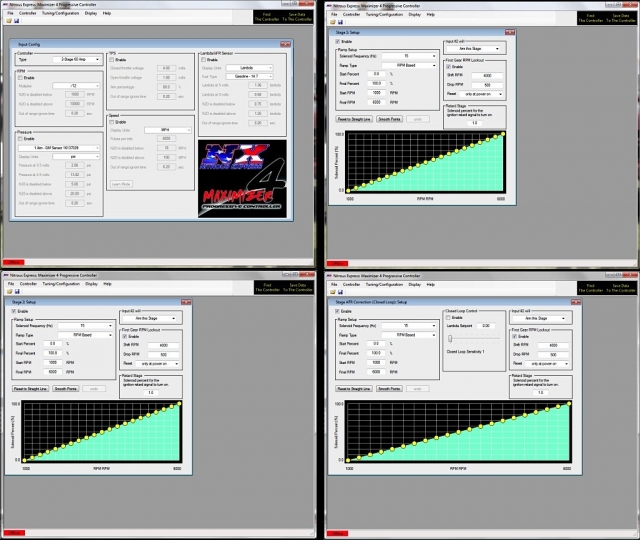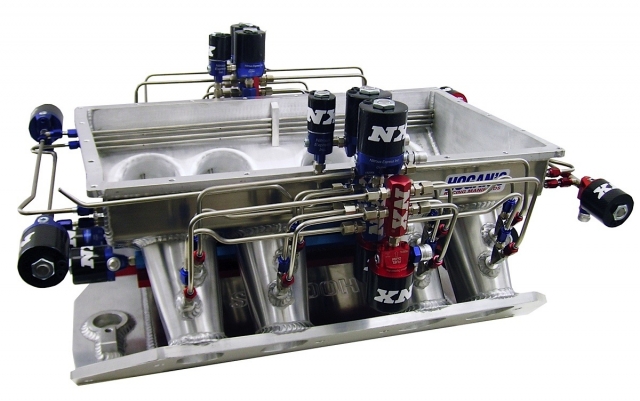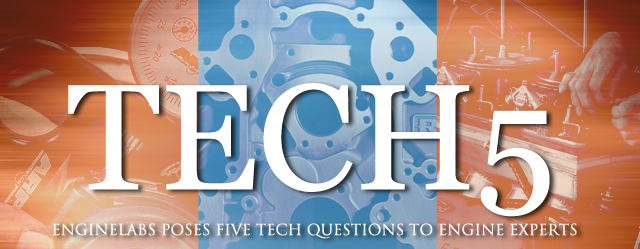 TECH5 is a regular feature where EngineLabs asks industry leaders five technical questions. This week’s guest is Mike Abney, sales manager for Nitrous Express.
TECH5 is a regular feature where EngineLabs asks industry leaders five technical questions. This week’s guest is Mike Abney, sales manager for Nitrous Express.
EngineLabs: Digital controllers and even some advanced ECUs can deliver nitrous at progressive rates and under different operating conditions, such as engine speed or boost. It seems like too many options are confusing the situation so how does one go about setting up these electronic aids for optimum performance?
Abney: The Nitrous Express Maximizer 4 progressive nitrous controller can be progressed by time, rpm, mph, throttle percentage or boost pressure. These progression options are described below:
- Time based progression. This option is a popular choice for drag racing applications where you always start from a dead stop. This option is very easy to fine tune so that you leave soft enough to eliminate wheel spin. As you go down track, the controller smoothly adds more nitrous as traction increases.
- RPM based progression – This option works great for vehicles that have enough traction to handle full nitrous power at the top of first gear. This mode allows you to add a little nitrous in the lower engine rpm and ramp into full nitrous as the engine rpm increases. This is a great option for vehicles with a tight torque converter. Since nitrous flow is limited to a small amount at low rpm, you can safely activate the nitrous at lower rpm, which will help to pull the car out of the hole.
- MPH (Mile Per Hour) progression – This option is great for racers who sometimes begin racing from a dead stop and other times begin racing from a rolling start. The nitrous controller will
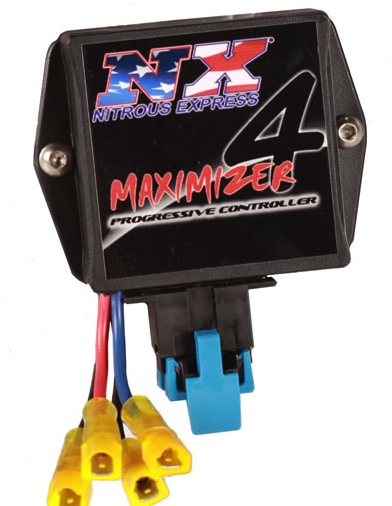 automatically limit nitrous to a smaller shot at low speeds where traction is limited while providing a larger shot at higher speeds where traction is more plentiful. Bracket racers can use this feature to set a mph nitrous cutoff for the ultimate in consistent ETs.
automatically limit nitrous to a smaller shot at low speeds where traction is limited while providing a larger shot at higher speeds where traction is more plentiful. Bracket racers can use this feature to set a mph nitrous cutoff for the ultimate in consistent ETs. - Throttle percentage progression – This option allows you to pedal the car in the event of wheel spin. Nitrous flow smoothly increases and decreases as you work the throttle, allowing you to regain traction and continue racing. This is very beneficial to road race and drifting vehicles. The throttle percentage feature is also beneficial for street cars because it allows you to introduce a small amount of nitrous at mid throttle while smoothly transitioning to full nitrous power as you press the throttle to the floor. The feeling is like driving a car with twice the cubic inches.
- Boost based progression – This is a useful option for use on turbocharged diesels and gasoline applications. Boost progression allows nitrous to come on strong to eliminate that dreaded turbo lag but then ramps out the nitrous smoothly to let the mighty turbo do its thing. The end result is monster power with zero lag, even with a HUGE turbo. On diesel applications it will not allow nitrous delivery until the engine starts to see boost, preventing a nitrous engine stall.
It’s worth noting that many ECUs and digital controllers on the market today cannot handle the amp load to accurately progress a high-output nitrous system. The Nitrous Express Maximizer 4 can handle up to 120 amps.
EngineLabs: What’s a good strategy for setting ignition timing when using nitrous?
Abney: When using nitrous, we recommend retarding ignition timing 2 degrees for every 50 horsepower of nitrous being sprayed. In the old days racers had to mechanically retard ignition timing for use with nitrous. While this worked okay when the nitrous was activated, the engine performed poorly when nitrous was not being sprayed. Fortunately, we now have electronic options for automatically triggering timing retard only when nitrous is being sprayed. The NX Maximizer 4 progressive nitrous controller features dual timing retard outputs (one for each stage) that automatically trigger the timing retard functions of an ignition box or an external timing retard device. Each timing retard output can be set to automatically activate when nitrous flow exceeds a used adjustable percentage on that stage.
EngineLabs: Why would you need four stages of nitrous, and is there any reason to expand to a 5th or 6th in a drag race engine?
Abney: Multiple stages are commonly used in high horsepower applications to aid in traction in the beginning of a run. This allows the racer to adjust the size of the first stage to a horsepower level that does not induce too much wheel spin. Additional stages are activated throughout the run as vehicle speed increases and more traction is available. Another benefit to multiple stages is that the later stages can be jetted leaner to compensate for bottle pressure drop. The need for a fifth or sixth stage really depends on the need for fine tuning ability and the overall power level required. NX offers custom systems with as many stages as the racer desires.
EngineLabs: What changes need to be made to the jetting or tuning when running E85?
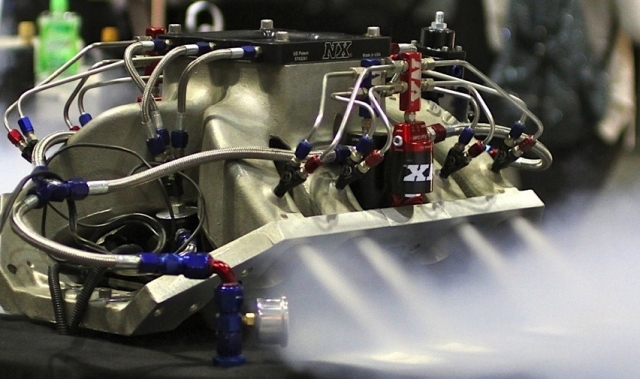 Abney: E85 works great with moderate size nitrous systems but there are a few things that should be considered. It takes a larger volume of ethanol per horsepower as compared to gasoline. This means that E85 will require larger fuel jets (NX offers E85 jet charts for every nitrous system offered). We also recommend checking with your nitrous system manufacturer to verify that the sealing material in your fuel solenoid is compatible with E85. It is worth noting that all Nitrous Express Gasoline solenoids produced since 2005 are compatible with any mixture of ethanol and gasoline E70, E85, E90 etc.
Abney: E85 works great with moderate size nitrous systems but there are a few things that should be considered. It takes a larger volume of ethanol per horsepower as compared to gasoline. This means that E85 will require larger fuel jets (NX offers E85 jet charts for every nitrous system offered). We also recommend checking with your nitrous system manufacturer to verify that the sealing material in your fuel solenoid is compatible with E85. It is worth noting that all Nitrous Express Gasoline solenoids produced since 2005 are compatible with any mixture of ethanol and gasoline E70, E85, E90 etc.
EngineLabs: What are the special challenges in running nitrous on a diesel engine?
NX offers multiple diesel specific nitrous systems ranging from street trucks to drag racing and pulling applications. Small diesel nitrous systems (150 horsepower or less) are pretty straightforward. Nitrous is simply injected into the boost tube between the turbo and the inlet to the engine at wide open throttle. High horsepower diesel nitrous systems require more control. Diesels can benefit from large amounts of nitrous when airflow through the engine is high (once the engine is under boost).
The problem is that if you try to inject large amounts of nitrous before the airflow is high the engine will stall. This is where the NX Maximizer 4 progressive nitrous controller really shines. The Max 4 allows you to fine tune the amount of nitrous being delivered based on boost pressure so that you can inject just enough nitrous at low boost levels to quickly spool the turbo but not so much that the engine coughs or stalls. As boost increases, the Maximizer automatically adds more nitrous so maximum power increases are achieved.



